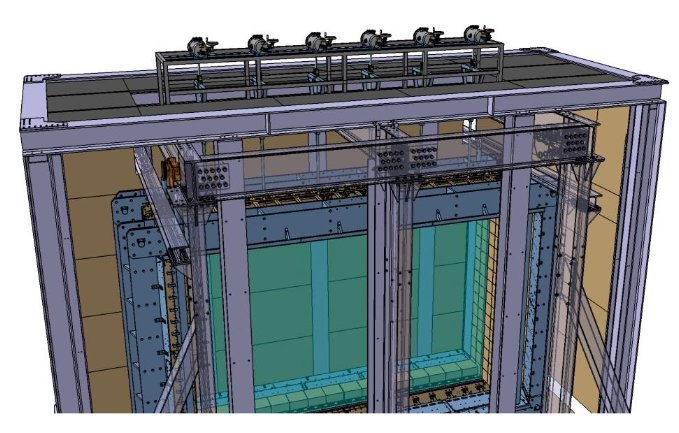NEMO3
Double beta decay without neutrino
The NEMO3 experiment, installed at the Laboratoire Souterrain de Modane (LSM), aims to observe the double beta decay without neutrino emission at a sensitivity level of 1024-25 years. The experimental demonstration of the existence of this process violating the conservation of the lepton number would prove the Majorana nature of the neutrino and eventually lead to theoretical interpretations beyond the framework of the Standard Model of elementary particles: massive Majorana neutrino exchange, V+A coupling, Majoron emission, supersymmetry. In the period 2007-2009, the group was mainly involved in two activities: the analysis of the experiment data to study the signals of the double decay of 150Nd and 82Se, as well as taking care of the daily monitoring of the calorimeter laser calibration data. The data analysis work was conducted as part of a thesis, defended in September 2008. Another component of this work was to search for signatures of detector contamination by 212Bi, the parent isotope of one of the most compromising radioisotopes in the experiment: the 208Tl. In particular, topologies signalling the delayed β-α cascade of 212Bi-212Po on and in the sources, but also in the wire chamber and on scintillator surfaces, were sought. These studies, both on the (ββ0ν) and (ββ2ν) processes and on the 212Bi induced background, are of particular interest to the R&D phase of the SuperNEMO project (see below). The NEMO group at LPC has developed a comprehensive set of software libraries for data analysis. This tool continues to be developed and used in a new thesis at LPC devoted to the analysis of the (ββ0ν) process to the excited states of the daughter nucleus and in a thesis carried out in a partner laboratory.
The SuperNEMO project
The SuperNEMO project aims to realize the measurement of the process (ββ0ν) at the sensitivity of 1026 years in the next 10 years, extrapolating the NEMO3 experiment by more than an order of magnitude. An R&D program validated by the Scientific Council of IN2P3 in March 2005, is being completed in order to determine the feasibility and characteristics of this future large experiment. The LPC group is involved in this project on two programs: the BiPo detector and the development of the front-end electronics of the SuperNEMO calorimeter. Since 2006, in the framework of an ANR program, the group is invested in the implementation of two prototype detectors whose objective is to study the ability to measure contaminations of ββ sources in 208Tl and 214Bi at sensitivity levels (a few mBq/kg) beyond the usual means of detection in this field (high-purity Germanium detector). In terms of physics results, the first phase of this R&D program has validated the measurement technique based on the detection of 212Bi by beta-alpha cascades from known fine contamination sources. The LPC is also involved in the realization of the front-end electronics of the SuperNEMO calorimeter. Finally, the laboratory is in charge of several transverse missions in the framework of the international collaboration NEMO/SuperNEMO: management of the mailing lists dedicated to the project and its subprograms, administration of the official web site of the collaboration, management of an information and software version control system shared by all the collaborators, responsibility for the computing resources at CCIN2P3. He receives the support of the local technical staff as well as of the IN2P3 computing center.

SuperNEMO demonstrator module